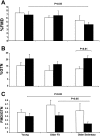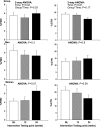Impact of age, sex, and exercise on brachial artery flow-mediated dilatation
- PMID: 19633208
- PMCID: PMC2755978
- DOI: 10.1152/ajpheart.00226.2009
Impact of age, sex, and exercise on brachial artery flow-mediated dilatation
Abstract
Flow-mediated dilatation (%FMD), an index of nitric oxide (NO)-mediated vasodilator function, is regarded as a surrogate marker of cardiovascular disease. Aging is associated with endothelial dysfunction, but underlying sex-related differences may exist and the effects of fitness and exercise on endothelial dysfunction in men (M) and women (W) are poorly understood. We compared %FMD of the brachial artery in 18 young [Y, 26 +/- 1 yr; 9 M and 9 W], 12 older fit (OF, 57 +/- 2 yr; 6 M and 6 W), and 16 older sedentary (OS, 59 +/- 2 yr; 8 M and 8 W) subjects. Glyceryl trinitrate (GTN) administration was used to assess endothelium-independent vasodilatation, and the FMD-to-GTN ratio was calculated to characterize NO dilator function in the context of smooth muscle cell sensitivity. Brachial %FMD in Y (7.1 +/- 0.8%) was significantly higher compared with OS (4.8 +/- 0.7%, P < 0.05), but not OF (6.4 +/- 0.7%). Differences between Y and OS subjects were due primarily to lower FMD in the OS women (4.3 +/- 0.6%). OS women exhibited significantly lower FMD-to-GTN ratios compared with Y (P < 0.05) and OF women (P < 0.05), whereas these differences were not apparent in men. Exercise training improved brachial artery NO dilator function (FMD-to-GTN ratio) after 24 wk (P < 0.05) in OS women, but not men. These findings indicate that maintaining a high level of fitness, or undertaking exercise training, prevents the age-related decline in the brachial artery vasodilator function evident in women. In OS men, who had relatively preserved NO dilator function, no training adaptations were observed. This study has potential implications for the prevention of conduit artery endothelial dysfunction in men and women.
Figures



References
-
- Betik AC, Luckham VB, Hughson RL. Flow-mediated dilation in human brachial artery after different circulatory occlusion conditions. Am J Physiol Heart Circ Physiol 286: H442–H448, 2004. - PubMed
-
- Black MA, Cable NT, Thijssen DH, Green DJ. Importance of measuring the time course of flow-mediated dilatation in humans. Hypertension 51: 203–210, 2008. - PubMed
-
- Brevetti G, Silvestro A, Schiano V, Chiariello M. Endothelial dysfunction and cardiovascular risk prediction in peripheral arterial disease. Circulation 108: 2093–2098, 2003. - PubMed
-
- Celermajer DS, Sorensen KE, Spiegelhalter DJ, Georgakopoulos D, Robinson J, Deanfield JE. Aging is associated with endothelial dysfunction in healthy men years before the age-related decline in women. J Am Coll Cardiol 24: 471–476, 1994. - PubMed
Publication types
MeSH terms
Substances
Grants and funding
LinkOut - more resources
Full Text Sources
Medical
Research Materials

